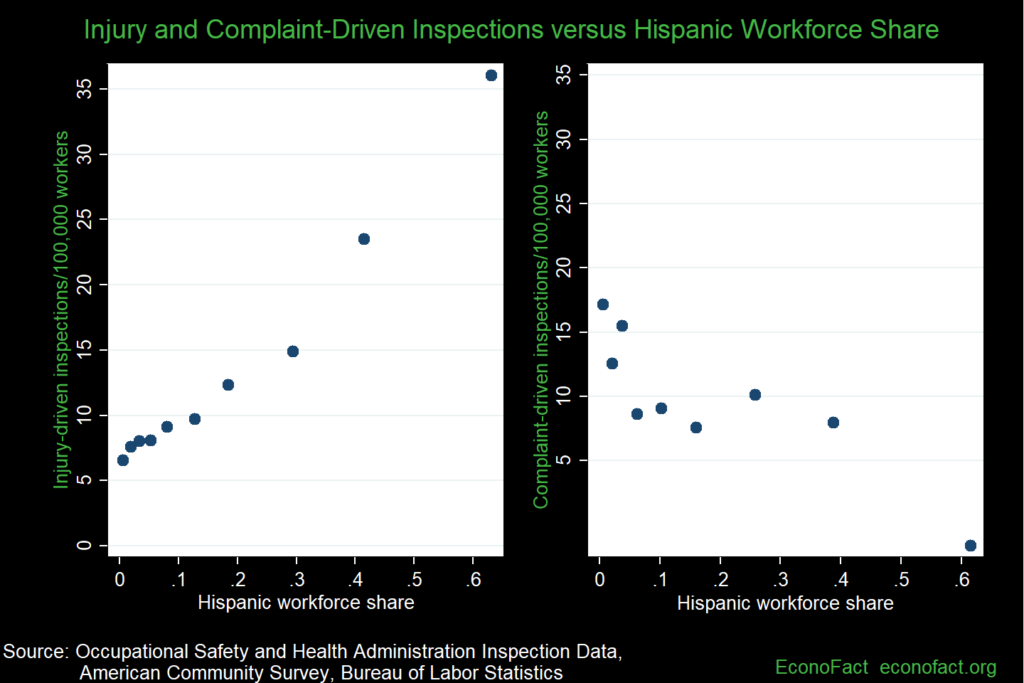This post was originally published by Econofact on May 26, 2020.

The Issue:
The public health emergency brought on by the coronavirus pandemic is putting front and center the health and safety risks that many workers face on a daily basis. Perhaps most salient, some traditionally low-risk occupations like grocery store cashiers are now the workers facing some of the highest risks of contracting COVID-19. More under the radar, the pandemic is exposing and exacerbating the hazards present in low-wage jobs in sectors that were already highly risky. Hispanic workers, both immigrants and native-born, are disproportionately likely to be working in these industries and occupations exposed to greater degrees of health and safety hazards. Despite these higher risks, however, recent research indicates that these workers are less likely to file complaints regarding illegal or hazardous conditions, and thus less likely to benefit from legal protections through regulations under the Occupational Safety and Health Act. What are the challenges Hispanic workers face to access safe and healthy workplaces? And how is this likely to ripple through to their families in the context of COVID-19?
Hispanic workers fill many low-wage essential jobs and face added challenges by having low bargaining power to advocate for safer work conditions.
The Facts:
Even before the COVID-19 pandemic, Hispanic workers were especially likely to face health and safety risks at work. The five industries in which the largest share of the workforce was Hispanic in 2018, and employed more than 500,000 workers, included landscaping, animal slaughtering and processing, crop production, “services buildings and dwellings” (i.e. housekeeping), and warehousing and storage, according to the Current Population Survey. Each of these industries had higher incidence rates of occupational injuries and illnesses than the national average (see here). In several of these cases COVID-19 has magnified the risks. Animal Slaughtering and Processing — a sector characterized by severe occupational hazards and rates of over twice the national average on injuries that require days away from work — are now the epicenter of some of the worst COVID-19 outbreaks. Crop and farm workers face new COVID-19-related risks stemming from the fact that they often live in crowded housing and still commute in crowded buses and vans, leading them unprotected from exposure (see here and here). Warehouse workers have faced their own increased risks as facilities and the pace of work present challenges to sanitation and maintaining social distancing (see here and here).
Hispanic low-wage workers are less likely to be in consumer-facing sectors.Jobs that typically employ Hispanic low-wage workers provide fewer opportunities and outlets for workers to use bargaining chips to demand for change. Whereas workers at Amazon, Instacart, Whole Foods, and other consumer-facing sectors have staged highly-publicized walkouts, social media campaigns, and other tactics to demand personal protective equipment, workers in animal slaughtering plants — largely invisible to consumers, and heavily dependent on keeping their jobs — have few options to speak up about unsafe conditions in a highly publicized way.
Hispanic workers are less likely to benefit from Occupational Safety and Health Act regulation designed to equalize worker rights to safe and healthy workplaces. Under the 1970 Occupational Safety and Health Act, workers have a right to issue a complaint to OSHA when they experience illegal or hazardous conditions. OSHA often follows up a complaint with an inspection, and evidence shows that inspections lead to improved safety outcomes. However, results from a preliminary study reveal that Hispanic workers are substantially less likely to exercise their right to complain to OSHA, even though they face higher rates of workplace hazards (see chart). As illustrated in the above graph, from a forthcoming article by Matthew Johnson and Amanda Grittner, in parts of the country in which a larger share of the labor force in the agriculture, construction and manufacturing sector is Hispanic, rates of workplace injuries are substantially higher. Yet, as shown on the graph on the right, despite these elevated risks, rates of complaints to OSHA are lower among more heavily Hispanic workforces. In other words, the tools available to workers to complement the enforcement of government regulation are less frequently used by Hispanic workers, exacerbating disparities in working conditions across groups.